1993 CADILLAC FLEETWOOD ESP
[x] Cancel search: ESPPage 184 of 386

Downloaded from www.Manualslib.com manuals search engine “I’ll be careful’’ isn’t the right answer. What if there’s an emergency, a
need to take sudden action, as when a child darts into the street?
A
person with a higher BAC might not be able to react quickly enough to
avoid the collision.
There’s something else about drinking and driving that many people
don’t know. Medical research shows that alcohol in a person’s system can
make crash injuries worse. That’s especially true for brain, spinal cord
and heart injuries. That means that
if anyone who has been drinking --
driver or passenger -- is in a crash, the chance of being killed or
permanently disabled is higher than
if that person had not been drinking.
And we’ve already seen that the chance of a crash itself is higher for
drinking drivers.
A CAUTION:
Drinking and then driving is very dangerous. Your reflexes,
perceptions, and judgment will be affected by even a small
amount of alcohol. You could have a serious
-- or even fatal --
accident if you drive after drinking. Please don’t drink and drive
or ride with
a driver who has been drinking. Ride home in a cab;
or if you’re with a group, designate a driver who will not drink. I
CONTROL OF A VEHICLE
You have three systems that make your vehicle go where you want it to
go. They are the brakes, the steering and the accelerator.
All three
systems have to do their work at the places where the tires meet the road.
11
d
a ,’ d
170
Page 190 of 386
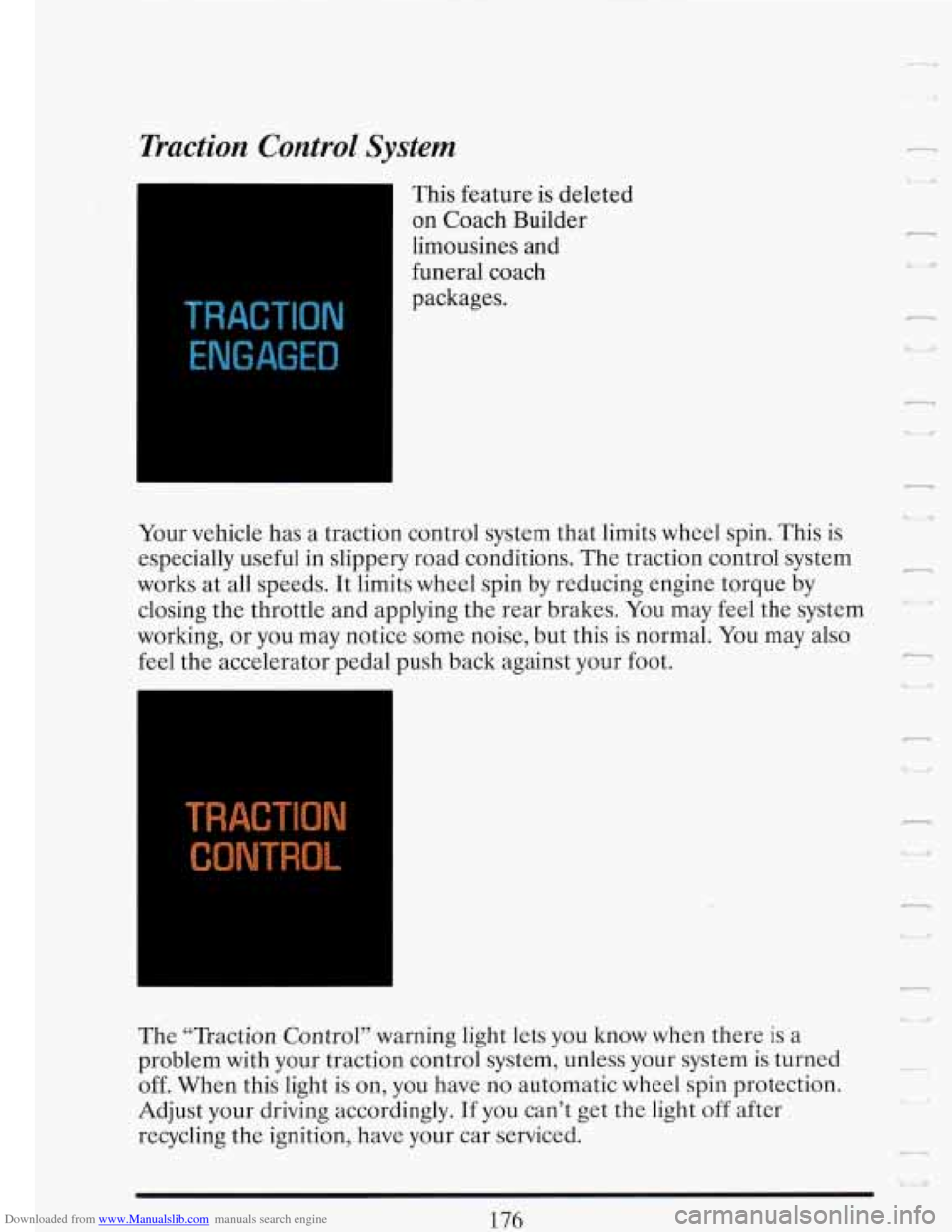
Downloaded from www.Manualslib.com manuals search engine Traction Control System
~ This feature is deleted
on Coach Builder
limousines and
funeral coach
packages. I
TRACTION
ENGAGED
Your vehicle has a traction control system that limits wheel spin. This is
especially useful in slippery road conditions. The traction control system
works at all speeds. It limits wheel spin by reducing engine torque by
closing the throttle and applying the rear brakes. You may feel the system
working, or you may notice some noise, but this is normal. You may also
feel the accelerator pedal push back against your foot.
I ~
i
TRACTION
I: I
The “Traction Control” warning light lets you know when there is a
problem with your traction control system, unless your system is turned
off. When this light is on,
you have no automatic wheel spin protection.
Adjust your driving accordingly. If you can’t get the light off after
recycling the ignition, have your car serviced.
n
u
c ‘I W
n
U
I
LrJ
-
L
..
r
1
L 7
I
UI
Page 191 of 386

Downloaded from www.Manualslib.com manuals search engine To limit wheel spin, especially in slippery road conditions, you should
always leave your traction control system on. But you can turn the
traction control system off
if you ever need to.
TRACTION
CONTROL
DISABLE
SWITCH
3
To turn the system off, press this switch. The “Traction Control” light will
come on and stay on. To turn the traction control system back on, you
must stop and turn off the ignition. Then restart the engine. The traction
control system automatically comes on whenever you start your vehicle.
-
Disc Brake Wear Indicators
Your Cadillac has front disc brakes and rear drum brakes.
-- Disc brake pads have built-in wear indicators that make a high-pitched
warning sound when the brake pads are worn and new pads are needed.
The sound may come and go or be heard all the time your vehicle is
.. - moving (except when you are pushing on the brake pedal firmly).
I
A CAUTION:
The brake wear warning sound means that sooner or later your
brakes won’t work well. That could lead to an accident. When
you hear the brake wear warning sound, have your vehicle
serviced. I
Page 197 of 386
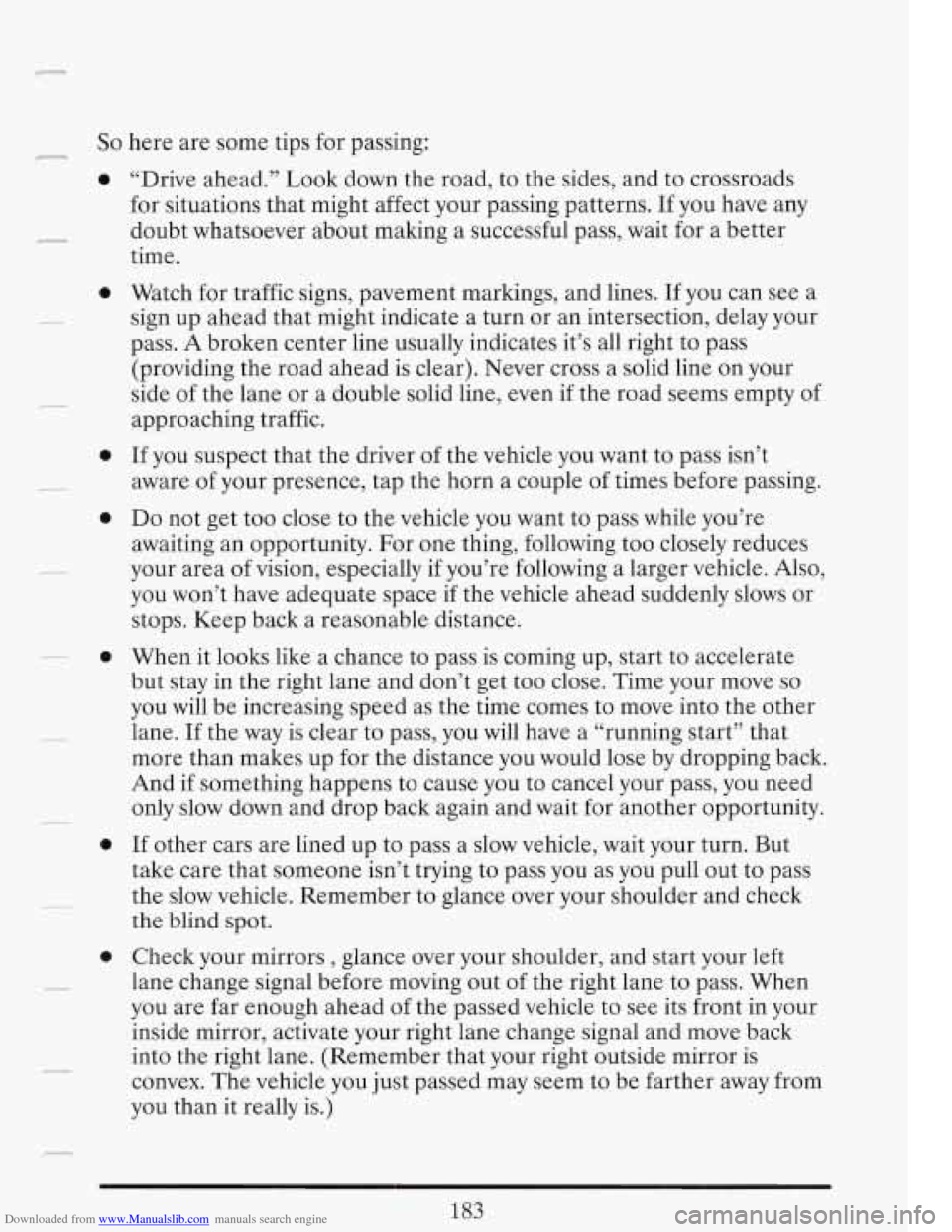
Downloaded from www.Manualslib.com manuals search engine So here are some tips for passing:
0
r
0
0
0
._ 0
0
0
“Drive ahead.” Look down the road, to the sides, and to crossroads
for situations that might affect your passing patterns.
If you have any
doubt whatsoever about making a successful pass, wait for
a better
time.
Watch for traffic signs, pavement markings, and lines. If you can see a
sign up ahead that might indicate a turn or an intersection, delay your
pass.
A broken center line usually indicates it’s all right to pass
(providing the road ahead is clear). Never cross a solid line on your
side
of the lane or a double solid line, even if the road seems empty of
approaching traffic.
If you suspect that the driver of the vehicle you want to pass isn’t
aware
of your presence, tap the horn a couple of times before passing.
Do not get too close to the vehicle you want to pass while you’re
awaiting an opportunity. For one thing, following too closely reduces
your area of vision, especially if you’re following a larger vehicle.
Also,
you won’t have adequate space if the vehicle ahead suddenly slows or
stops. Keep back a reasonable distance.
When it looks like a chance to pass is coming up, start to accelerate
but stay in the right lane and don’t get
too close. Time your move so
you will be increasing speed as the time comes to move into the other
lane. If the way is clear to pass, you will have a “running start” that
more than makes up for the distance you would lose by dropping back.
And if something happens
to cause you to cancel your pass, you need
only slow down and drop back again and wait for another opportunity.
If other cars are lined up to pass a slow vehicle, wait your turn. But
take care that someone isn’t trying to pass you as you pull out to pass
the slow vehicle. Remember to glance over your shoulder and check
the blind spot.
Check your mirrors
, glance over your shoulder, and start your left
lane change signal before moving out of the right lane to pass. When
you are far enough ahead of the passed vehicle to see its front in your
inside mirror, activate your right lane change signal and move back
into the right lane. (Remember that your right outside mirror is
convex. The vehicle you just passed may seem to be farther away from
you than it really is.)
Page 198 of 386
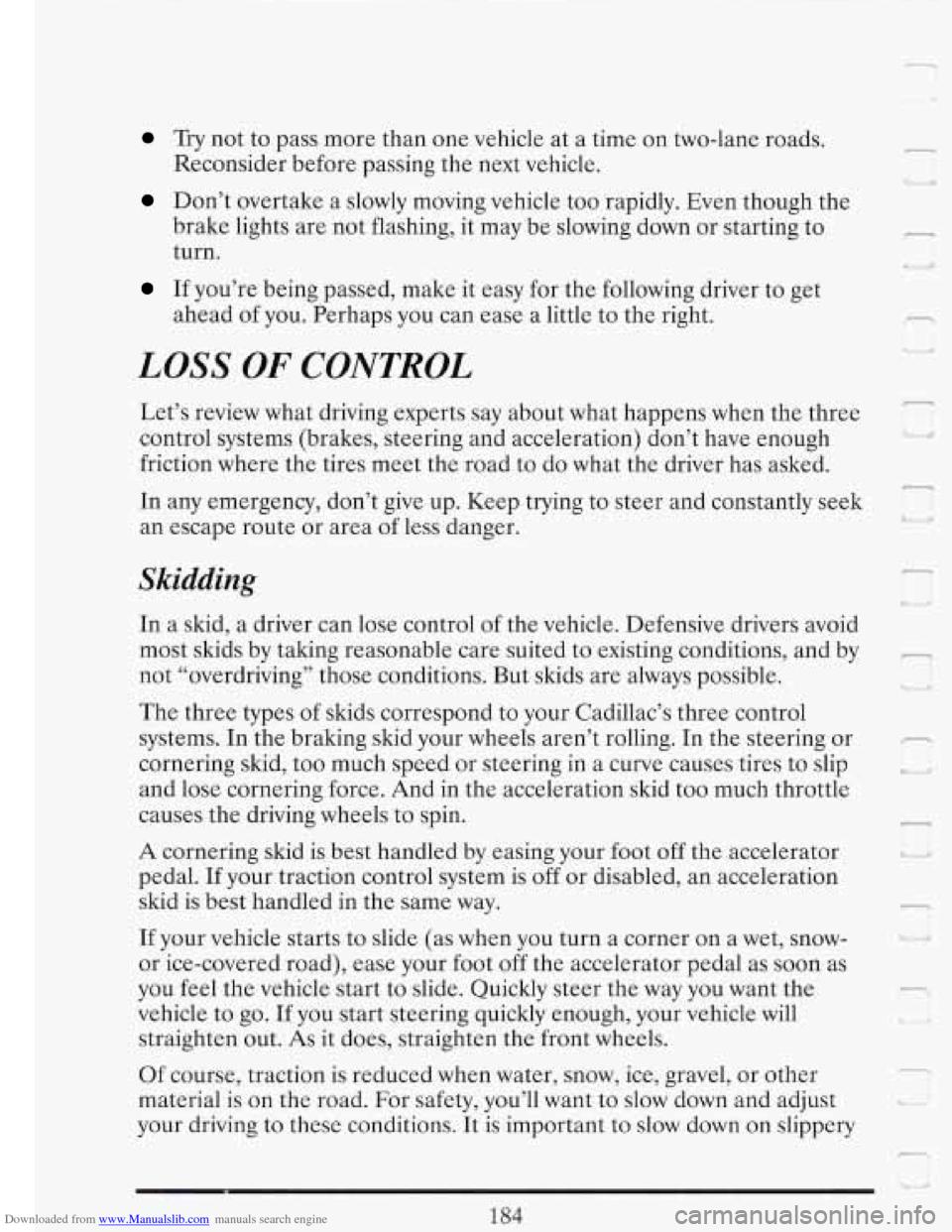
Downloaded from www.Manualslib.com manuals search engine Try not to pass more than one vehicle at a time on two-lane roads.
Reconsider before passing the next vehicle.
Don’t overtake a slowly moving vehicle too rapidly. Even though the
brake lights are
not flashing, it may be slowing down or starting to
turn.
If you’re being passed, make it easy for the following driver to get
ahead
of you. Perhaps you can ease a little to the right.
LOSS OF CONTROL
i
r
I/ U
Let’s review what driving experts say about what happens when the three
control systems (brakes, steering and acceleration) don’t have enough
’; I I
friction where the tires meet the road to do what the driver has asked.
r
In any emergency, don’t give up. Keep trying to steer and constantly seek
an escape route or area
of less danger.
-
le
Skidding
In a skid, a driver can lose control of the vehicle. Defensive drivers avoid
most skids by taking reasonable care suited to existing conditions, and by
._
not “overdriving” those conditions. But skids are always possible. < .,
The three types of skids correspond to your Cadillac’s three control
systems. In the braking skid your wheels aren’t rolling.
In the steering or
cornering skid, too much speed or steering in a curve causes tires to slip
and lose cornering force. And in the acceleration skid too much throttle
causes the driving wheels to spin.
A cornering skid is best handled by easing your foot off the accelerator
pedal.
If your traction control system is off or disabled, an acceleration
skid is best handled in the same way.
If your vehicle starts to slide (as when you turn a corner on a wet, snow-
or ice-covered road), ease your foot off the accelerator pedal as soon as
you feel the vehicle start to slide. Quickly steer the way you want the
vehicle to
go. If you start steering quickly enough, your vehicle will
straighten out.
As it does, straighten the front wheels.
Of course, traction is reduced when water, snow, ice, gravel, or other
material is on the road. For safety, you’ll want to slow down and adjust
your driving to these conditions. It is important to slow down on slippery
Lj
il t
1
-.
184
Page 200 of 386
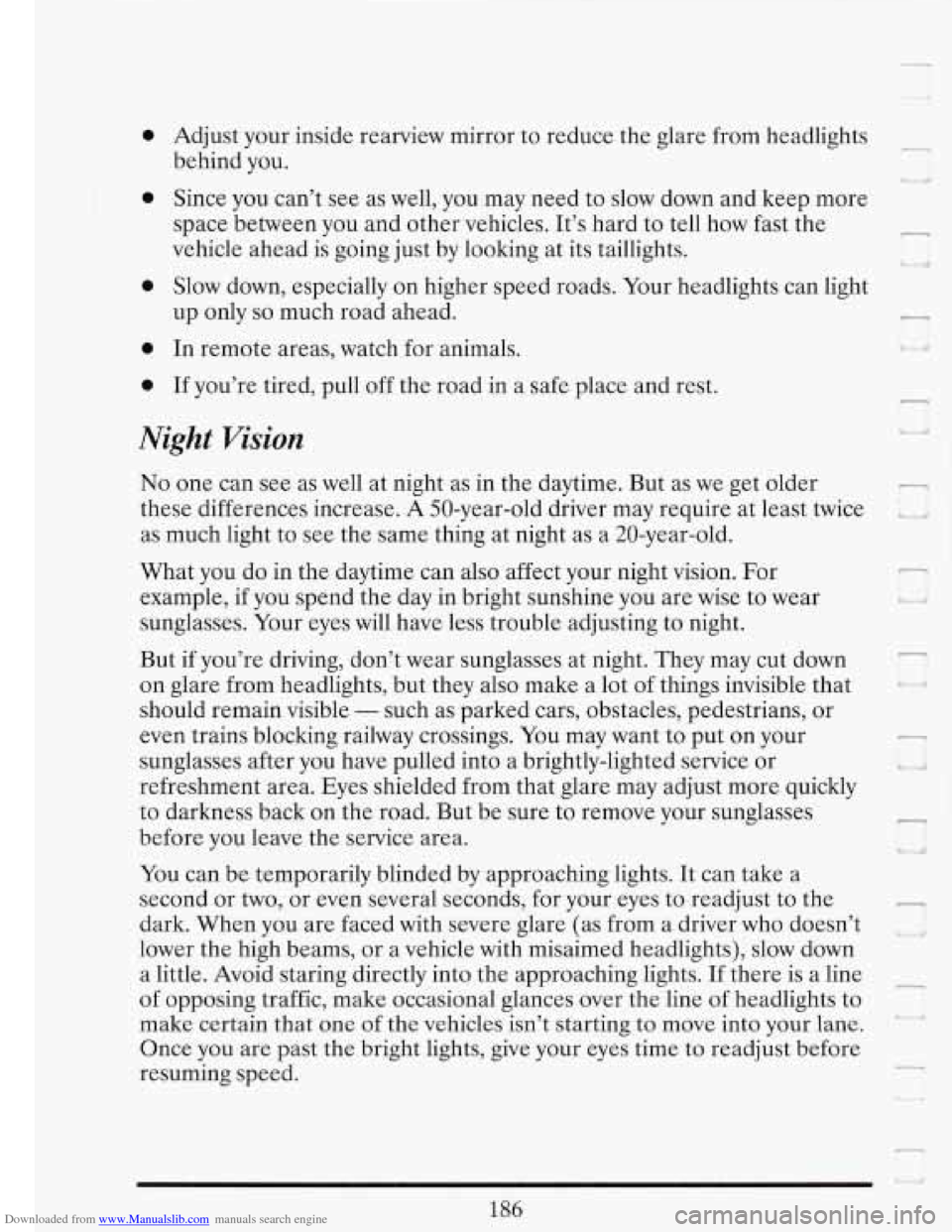
Downloaded from www.Manualslib.com manuals search engine 0
0
0
0
0
Adjust your inside rearview mirror to reduce the glare from headlights
behind you. -
Since you can’t see as well, you may need to slow down and keep more
space between you and other vehicles. It’s hard to tell how fast the
vehicle ahead is going just by looking at its taillights.
Slow down, especially on higher speed roads. Your headlights can light
up only
so much road ahead.
In remote areas, watch for animals.
If you’re tired, pull off the road in a safe place and rest.
Night Vision
f-I
i
No one can see as well at night as in the daytime. But as we get older -
these differences increase. A 50-year-old driver may require at least twice i,
as much light to see the same thing at night as a 20-year-old.
What you do in the daytime can also affect your night vision. For
example, if you spend the day in bright sunshine you are wise to wear
sunglasses. Your eyes will have less trouble adjusting to night.
But if you’re driving, don’t wear sunglasses at night. They may cut down
on glare from headlights, but they also make a lot of things invisible that
should remain visible
- such as parked cars, obstacles, pedestrians, or
even trains blocking railway crossings.
You may want to put on your
sunglasses after you have pulled into a brightly-lighted service or
refreshment area. Eyes shielded from that glare may adjust more quickly
to darkness back on the road. But be sure to remove your sunglasses
before you leave the service area.
I
3:
You can be temporarily blinded by approaching lights. It can take a
second or
two, or even several seconds, for your eyes to readjust to the r
dark. When you are faced with severe glare (as from a driver who doesn’t
lower the high beams, or a vehicle with misaimed headlights), slow down
a little. Avoid staring directly into the approaching lights.
If there is a line
of opposing traffic, make occasional glances over the line of headlights to
make certain that one of the vehicles isn’t starting to move into your lane.
Once you are past the bright lights, give your eyes time to readjust before
resuming speed.
I.-
-
i*
It 81
186
Page 202 of 386
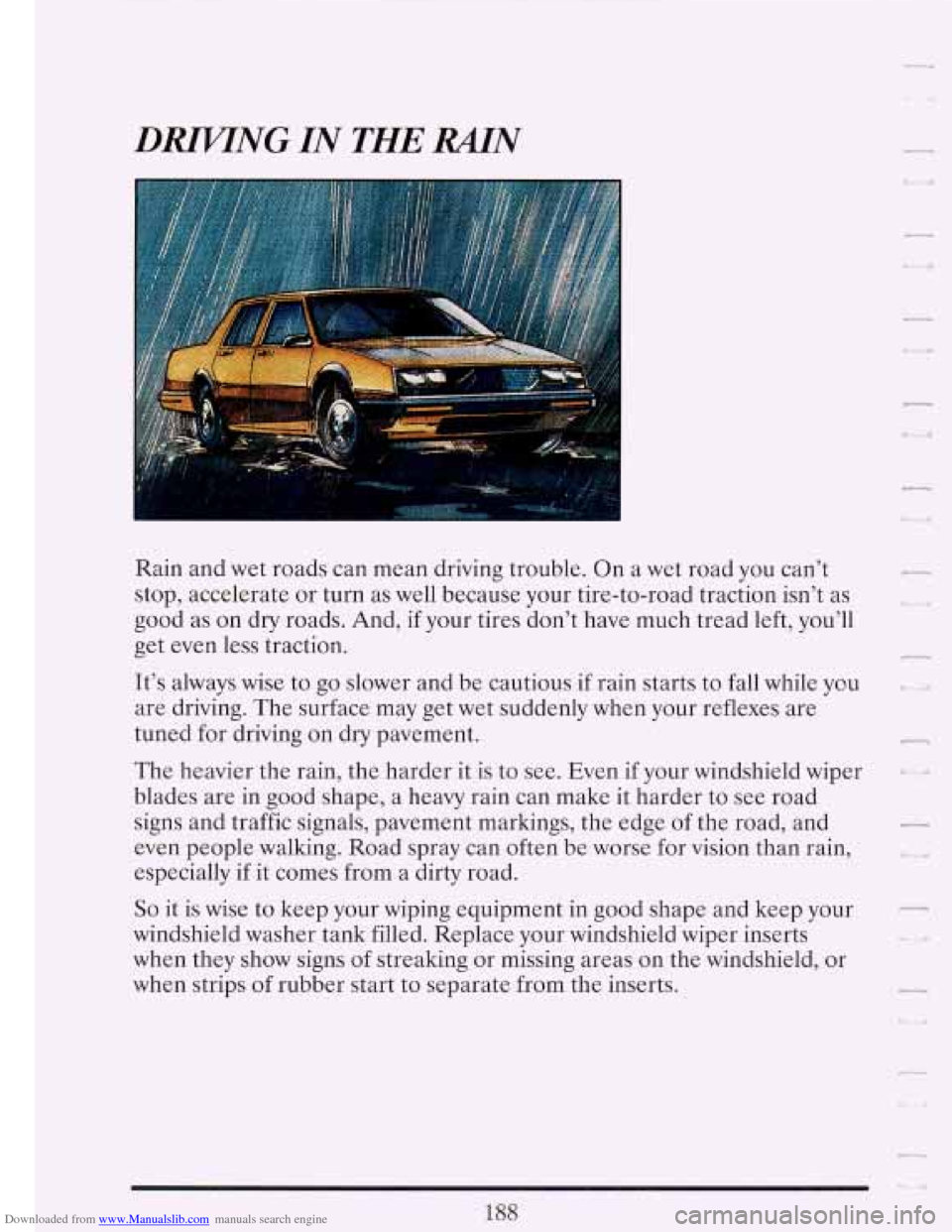
Downloaded from www.Manualslib.com manuals search engine DMNG IN THE MN
Rain and wet roads can mean driving trouble. On a wet road you can’t
stop, accelerate or turn as well because your tire-to-road traction isn’t as
good as on dry roads. And, if your tires don’t have much tread left, you’ll
get even less traction.
It’s always wise to
go slower and be cautious if rain starts to fall while yc.u II
are driving. The surface may get wet suddenly when your reflexes are
tuned for driving on dry pavement.
n
The heavier the rain, the harder it is to see. Even if your windshield wiper
blades are in good shape, a heavy rain can make it harder to see road
signs and traffic signals, pavement markings, the edge of the road, and
even people walking. Road spray can often be worse
for vision than rain,
especially if it comes from a dirty road.
So it is wise to keep your wiping equipment in good shape and keep your --
windshield washer tank filled. Replace your windshield wiper inserts
when they show signs of streaking or missing areas on the windshield, or
when strips
of rubber start to separate from the inserts.
188
Page 204 of 386
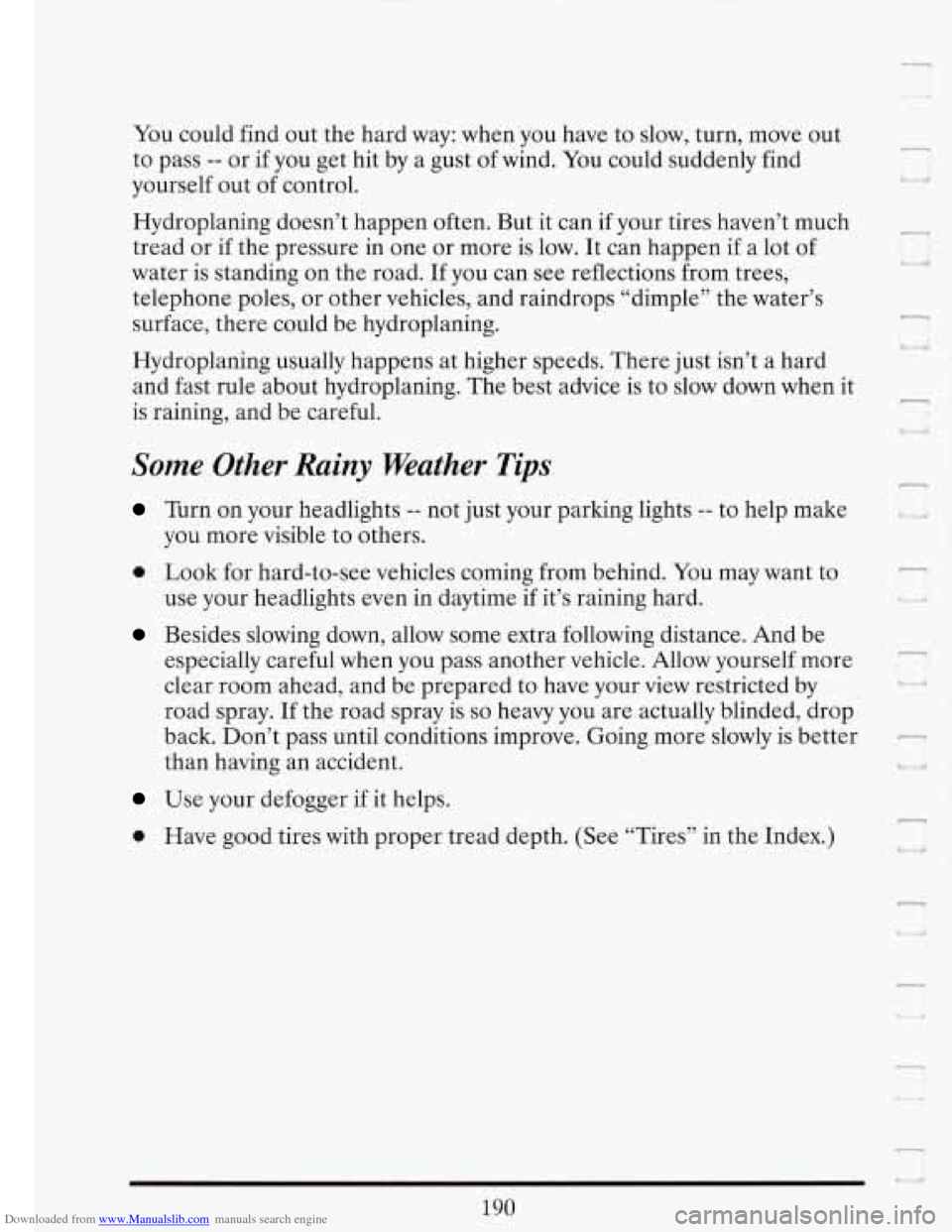
Downloaded from www.Manualslib.com manuals search engine You could find out the hard way: when you have to slow, turn, move out
to pass
-- or if you get hit by a gust of wind. You could suddenly find
yourself out of control.
Hydroplaning doesn’t happen often. But it can if your tires haven’t much
tread or if the pressure in one or more is low. It can happen if a lot of
water is standing on the road.
If you can see reflections from trees,
telephone poles, or other vehicles, and raindrops “dimple” the water’s
surface, there could be hydroplaning.
Hydroplaning usually. happens at higher speeds. There just isn’t a hard
and fast rule about hydroplaning. The best advice is to slow down when it
is raining, and be careful.
Some Other Rainy Weather Tips
Turn on your headlights -- not just your parlung lights -- to help make
you more visible to others.
0 Look for hard-to-see vehicles coming from behind. You may want to
use your headlights even in daytime if it’s raining hard.
Besides slowing down, allow some extra following distance. And be
especially careful when you pass another vehicle. Allow yourself more
clear room ahead, and be prepared to have your view restricted by
road spray.
If the road spray is so heavy you are actually blinded, drop
back. Don’t pass until conditions improve. Going more slowly is better
-
than having an accident. I
L1
I
Use your defogger if it helps.
0 Have good tires with proper tread depth. (See “Tires” in the Index.)
-
Y
190 I